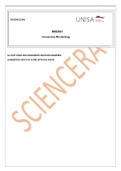Exam (elaborations)
MIB2601 NOTES - LAST 5 YEARS EXAM QUESTIONS WITH ANSWERS - UNISA MODULE 2023
- Course
- Institution
The document containing introductory microbiology exams with answers is the perfect guide for students preparing for the 2023 microbiology exams. This comprehensive guide is designed to help students understand the fundamental concepts of microbiology, including the structure and function of microo...
[Show more]



